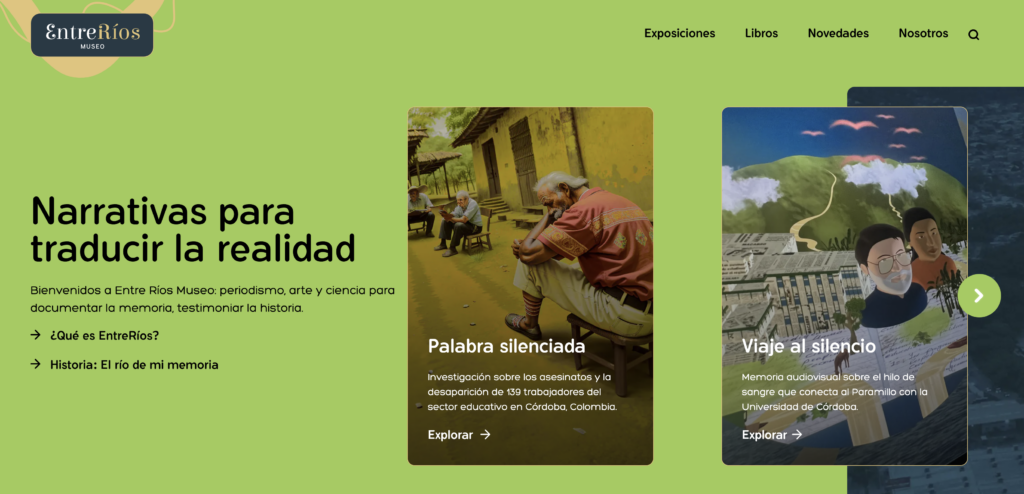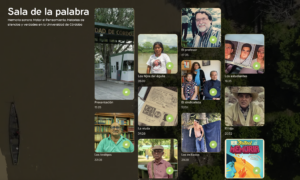Covering Colombia's armed conflict for more than 20 years can be a heavy burden.
"For me, at some point in my life, journalism became insufficient," said Ginna Morelo, a Colombian journalist from the department of Córdoba, in the Colombian Caribbean. It was insufficient to narrate the pain, but especially as an agent of change.
The violence in her native Montería, capital of Córdoba, to which she dedicated her coverage brought threats and other restrictions to her journalistic practice that led her to move to Bogotá, the country's capital, 10 years ago. However, she never forgot what she experienced in her region and the stories silenced because of the armed conflict. Those in Córdoba experienced this conflict with particular cruelty because of the actions of so-called paramilitary groups. Stories were silenced, such as the one she titled 'The university takeover.' She thought of publishing it in her 2009 book 'Tierra de Sangre' (Land of blood), but could not.
To give an outlet to everything she had "stuck in her throat," Morelo began a doctorate in Latin American Social Studies. Her dissertation topic was about silence during war: "What happens when society becomes silenced for different reasons," the journalist told LatAm Journalism Review (LJR). Part of this project made it necessary to carry out field work that had been truncated years ago.
For Morelo, the COVID-19 pandemic meant the possibility of returning to her region and doing the field work — mapping and gathering information through social research techniques "to get close to others."
Almost serendipitously, in 2021 Morelo won a scholarship from Reporters Without Borders Germany, which took her to Berlin for a year and allowed her to finish all her research. With her extensive reporting work done in 2020 and prior years, her experience in covering the armed conflict and with the tools and time of the scholarship, Entre Ríos Museo [Entre Ríos Museum] was born. It's a digital space Morelo defines as "journalism, art and science to document collective memory and bear witness to history. Mestizo [mixed] narratives to translate reality." She is its director.
Entre Ríos focuses mainly, and for now, on the department of Córdoba. In fact, its very name has to do with the area: Entre Ríos was the name the department was initially going to have and represents "the land of an amphibian culture," as described by a sociologist from the Colombian Caribbean.
Like all museums, Entre Rios is designed for exhibitions. On July 31, the second was presented, "Palabra silenciada [Silenced word]," an investigation into the murder and disappearance of 139 members of the educational field in Córdoba.
"It’s the first public database that tells the story of systematic crimes against teachers," explains Morelo, who in addition to directing the museum is a professor at the Pontificia Universidad Javeriana in Bogotá, an organization that also supports Entre Ríos.

Screenshot of the two exhibitions of the Entre Ríos Museo of Colombia. The project makes visible stories silenced by the armed conflict.
For Morelo, violence against teachers in Córdoba (both at universities and schools) was one of those issues she knew she wanted to make visible. Not only because it had remained unpublished in her 2009 book, but also because it’s about violence that left a mark on several generations in her region.
"My main research hypothesis is that paramilitarism sought something more than land — paramilitarism sought to wipe out critical thinking in a region and even install a way of thinking," Morelo said. In her research, she found that these groups even imposed deans on the only public university in the region.
"What we want to show is that obliterating critical thinking led to the murder of professors in the region. And taking over the public higher education center [...] that had a greater impact [...] and that means that at least four generations lost the chance of understanding and comprehending the magnitude of a region and its social science," Morelo said.
In fact, one of her sources pointed out that this is why there are so many lawyers and public accountants in the region, which is not itself a criticism, and that generations of artists, writers or sociologists had been lost "because they were silenced." In the end, as one of the protagonists of one of the podcasts says, “the paramilitaries achieved their goal, which was to install a silence against criticism and construction," the journalist said.
This topic of violence against teachers was also part of the first exhibition, "Viaje al silencio [Journey to silence]," which is the story of the "thread of blood that connects the violence of paramilitarism against the Emberá Katío peoples of the department of Córdoba and the professors of the University of Córdoba," Morelo said.
This first exhibition, of which the journalist is the author of almost all the documents, includes the book 'The voice of the pencils.' In it, Morelo finally narrates the takeover of the university by paramilitary groups, which she had wanted to tell since 2009. According to her records, some of the professors were investigating environmental damage to the Embera Katío people.
Exploring Entre Ríos Museo is a journalistic storytelling experience with a variety of resources that allows the reader to get closer to stories that had been rendered invisible.
In the case of Palabra Silenciada, the company — as Morelo calls the team that brings together journalists, documentary filmmakers, researchers, animators, developers, among those in other disciplines — experimented with artificial intelligence generative art.
"This animation, created with generative art, recreates in a metaphorical way what was experienced in the region where dozens of teachers were murdered and disappeared. The illustrated characters are only a fictitious representation of reality," reads the exhibition.
Indeed, using artificial intelligence led to "quite a few discussions" especially with the creative director of Entre Rios, who is also Ginna's brother, Daniel Morelo. In the discussions, ethics were always put first. For Ginna, it was essential that the images were really culturally associated with what they wanted to tell. For this reason, she said, many demos were made before giving final approval.
"I think there are tools that can one day generate incredible creative possibilities, but we must never lose sight of the fact that ethics, the principles of the profession and transparency in telling how we do it come first," the journalist said about the use of artificial intelligence in journalism. "I think that our proposal was to do it respecting all this. Let's see where new explorations we want to carry out lead us."
But the use of artificial intelligence is not the only resource used in the Entre Ríos exposés. In both Palabra silenciada and Viaje al silencio, the company thought of different show rooms to explore the formats: the word room (where sound resources are found), the audiovisual room, and the time room.
In Viaje al silencio, the audiovisual room features a 58-minute documentary made by Morelo together with Diego Pérez (audiovisual producer), as well as a video of a song donated to Entre Ríos by the Cordoban singer Adriana Lucía. Palabra Silenciada features an ethnographic video made by one of the victims of this violence.
In Sala de la palabra, for both exhibitions, collective memory is narrated. In Journey to Silence there is a podcast of 11 chapters, while the second exhibition has a series of three chapters on murders, disappearance and exile of teachers.
"It is worth mentioning that the museum also has a very cool thing, and that is that all the exhibitions will always have timelines that show press documents we used for research, which can be consulted there," Morelo explained about the Time Room.
"What we intend, the team [...] is to create exhibitions that can link animation, build sound and audiovisual memory," Morelo said. "Those key words I mentioned of journalism, art and science are what we want to show by way of an exhibition."
With this in mind, the company is already working on its third exhibition, which it hopes to launch in November. Although Morelo did not want to share the topic in advance, she said Entre Rios will not focus exclusively on collective memory of the conflict.
"It was important to start and begin with silence, with what was silenced, because to lift the veil off all these things that deserve to have a space, that deserve to have active listening — which is what the museum proposes —, we will be able to see other very nice and very beautiful things the conflict made invisible," the journalist said. "Then, the third exhibition aims to shed light on a place and a supremely beautiful topic that relates to ecology and which will allow me to recover memories of a whole territorial space."

In Sala de la palabra in the exhibition Viaje al silencio you can find a podcast of 11 episodes about violence against teachers in Córdoba, Colombia. (Screenshot Entre Ríos Museo).
Morelo expects Entre Ríos to launch two exhibitions per year. And she is working on a project to take the museum away from the virtual world — she wants to have a traveling exhibition in Montería before the end of the year, and eventually have a physical museum in Montería as well.
In addition to Reporters Without Borders and the Pontificia Universidad Javeriana, Entre Ríos also has the support of Konrad Adenauer Stiftung (KAS) in Colombia, Consorcio para Apoyar el Periodismo en la Región (Capir) and the Institute for War and Peace Reporting (IWPR).
At times, Entre Rios has even relied on resources from Morelo herself, for whom the inadequacy of journalism was overcome by the enormous possibilities of interdisciplinary association and she turned the museum into her life project.
"I believe journalism has enormous possibilities when it’s combined with social sciences and art to do what today is called research/creation and that made me fall in love with it. And that’s why [...] it’s a life project I’m developing and which is linked to an interdisciplinary construction practice," said Morelo, who also stressed the need to do it with friends.
"This would not be possible, or at least I conceive it that way. I believe the great job of investigating, doing journalism, creating art, can only be done among friends. I am a great believer in that. I mentioned that when we were awarded the Gabo Prize in 2018. I said, 'this is done with friends' and I believe the same today. I still believe that even more now. Only with friends can you reach these results and these possibilities."
Banner: Illustration taken from generative art made by Entre Ríos Museo for the exhibition Palabra silenciada.